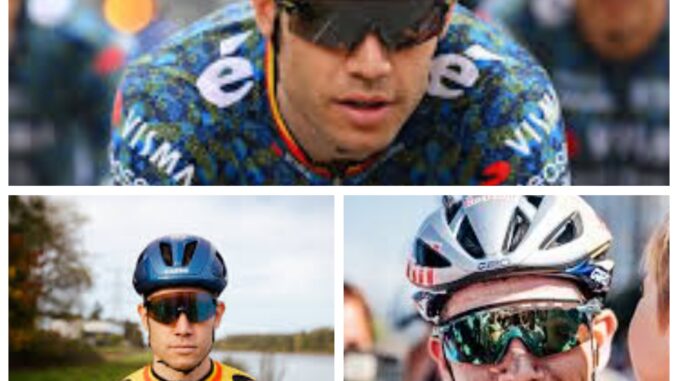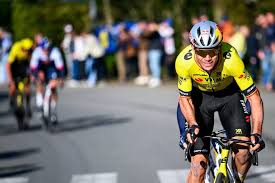
Wout van Aert, the Belgian cycling star, has made his voice heard once again following the serious crash that sidelined him earlier this year. In an emotional interview, he opened up about the physical and mental toll of the accident, his rehabilitation journey, and the doubts he faced in its aftermath. This crash, which occurred earlier in 2024, didn’t only affect his sporting career but also had significant personal consequences. What began as an ordinary race day took a painful turn that upended his entire season.
The Crash and Immediate Impact
The incident occurred on March 27, 2024, during the one-day race Dwars door Vlaanderen. Van Aert was in peak form, regarded as one of the top contenders for this event, as well as the upcoming Tour of Flanders and Paris-Roubaix. However, during a critical moment of the race, at high speed on a technical section of road, disaster struck. Van Aert crashed hard, alongside several other riders. The images from the crash were harrowing, showing Van Aert writhing in pain on the asphalt, visibly shaken, and suffering from obvious injuries.
Medical reports later revealed that Van Aert had sustained several fractures, including to his collarbone and ribs. The injuries were severe, and the initial prognosis was that he would be out of competition for months. This abrupt end to his spring campaign also dashed his hopes in the classic races he had been preparing for rehabilitation.
For an athlete like Van Aert, who thrives on competition and achieving peak performance, the crash was a massive mental blow. In a recent interview with Belgian media, he candidly discussed the challenges he faced after the accident:
“I didn’t just lose my physical freedom, but also part of my identity. When you live for a goal for months, and it’s taken from you in an instant, it hurts deeply,” Van Aert shared.
Rehabilitation proved to be a long and arduous process. At first, Van Aert could barely move without pain. He worked daily with physiotherapists to regain his mobility. However, alongside the physical recovery, doubt began to creep in. Would he ever return to the same level? Would he have the courage to descend with the same aggressiveness or sprint with the same explosiveness?
“You start asking yourself, ‘Is it worth it? What if it happens again?’” Van Aert admitted. “But then you remember why you do this. Not for the fame or money, but for the love of the sport. For the fight. For the freedom on the bike.”

Fortunately, Van Aert wasn’t facing this challenge alone. His team, Visma | Lease a Bike (formerly Jumbo-Visma), showed tremendous solidarity. Team manager Richard Plugge praised Van Aert’s mindset, emphasizing that he was given all the time he needed to recover, without any external pressure. At home, Van Aert found peace and strength from his family.
His wife, Sarah De Bie, and their young son Georges became a source of support during this difficult time. “Being a father during such a period helps you put everything in perspective,” Van Aert said. “You’re not just defined by victories, but by how you deal with setbacks.”
Following his crash, Van Aert also expressed criticism regarding the organization of certain races and the overall safety in the peloton. According to him, there is still too little attention paid to dangerous courses, narrow roads, and poorly placed obstacles.
“We’re expected to perform at our best on roads that aren’t suited for it. Sometimes it feels like a lottery — the unlucky one hits the ground. That needs to change,” Van Aert stated.
His remarks sparked a wider conversation within the peloton. Other top riders, including Mathieu van der Poel and Remco Evenepoel, joined in the call for improved safety measures. Discussions are now underway about stricter course inspections, better communication between race organizers and riders, and using technology to map out risky zones.
Months after the crash, Van Aert’s recovery is showing positive signs. He has returned to cycling, first on the rollers and later cautiously outdoors. While a specific date for his comeback hasn’t been set, he is aiming for the 2025 Tour de France, or perhaps a preparatory race like the Dauphiné.
“I don’t want to rush it. When I return, I want to be one hundred percent. But believe me: I will come back. Stronger, wiser, and hungrier than ever.”
Van Aert’s story goes beyond cycling. It’s about perseverance, overcoming adversity, and the power of vulnerability. By speaking out about his doubts and his physical and mental recovery, he sends a powerful message: top-level sport isn’t just about winning, but also about the process, the crashes, and the resilience to rise again afterward.
Fans and fellow athletes see him as an example — not only as a cyclist but as a person. His message is clear: crashes can be life-changing, but they don’t define who you are. It’s what you do afterward that matters. Wout van Aert’s crash left deep scars, but it also revealed his character. His openness, determination, and call for better safety have left a lasting impact on the cycling world. The community now eagerly anticipates his return. One thing is certain: when Van Aert lines up at the start once more, he will carry a story that goes far beyond sport.
Leave a Reply